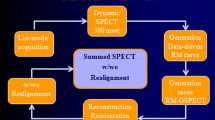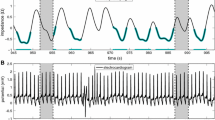Abstract
Objectives
This article assesses the effect of a new correction technique (“motion-frozen heart”) which compensates for the previously described nonuniform blurring of myocardial perfusion imaging (MPI) due to respiration motion or cardiac contraction.
Methods
Respiratory and ECG-gated one-day 99mTc-MIBI MPI studies performed in 48 patients were evaluated. MPI scans were acquired on a gamma camera supporting list-mode functionality synchronized with an external respiratory strap and an ECG device. Respiratory and cardiac-gated bins were generated using the acquired list file. Respiratory-gated bins were corrected for respiratory motion, followed by correction for cardiac contraction motion. In addition, cardiac contraction correction was applied to cardiac-gated bins uncorrected for respiratory motion. Bullseye maps were generated for uncorrected MPI studies, as well as following correction for respiratory motion, cardiac contraction, and both. The mean difference between each of the correction vs the uncorrected bullseye was calculated. Visual assessment of image quality, severity, and extent of the uncorrected perfusion images and following each of the corrections was performed.
Results
Average motion due respiration was 7.0 ± 2.6 mm in the axial plane. The maximal score difference in segmental uptake greater than 10% was found in 2%, 15%, and 25% following respiratory correction, contraction correction, and dual corrections, respectively. Percent of scans classified with an excellent image quality was 13%, 21%, 42%, and 52% for the uncorrected images and following respiratory correction, contraction correction, and dual corrections, respectively.
Conclusions
A technique that compensates for motion of the heart due to respiration and cardiac contraction in MPI-SPECT was evaluated. Compensating for both respiration and cardiac contraction had the greatest effect on perfusion images resulting in significantly improved image quality.






Similar content being viewed by others
References
Pitman AG, Kalff V, Van Every B, et al. Effect of mechanically simulated diaphragmatic respiratory motion on myocardial SPECT processed with and without attenuation correction. J Nucl Med 2002;43:1259–67.
Tsui BMW, Segarsl WP, Lalush DS. Effects of upward creep and respiratory motion in myocardial SPECT. IEEE Trans Nucl Sci 2000;47:1192–5.
Segars PW, Lalush DS, Tsui BMW. Modeling respiratory mechanics in the MCAT and Spline-based MCAT phantoms. IEEE Trans Nucl Sci 2001;48:89–97.
Segars PW, Tsui BMW. Study of the efficacy of respiratory gating in myocardial SPECT using the new 4-D NCAT. IEEE Trans Nucl Sci 2002;49:675–9.
Cho K, Kumiata S, Okada S, et al. Development of respiratory gated myocardial SPECT system. J Nucl Cardiol 1999;6:20–8.
Ablitt NA, Gao J, Keegan J, et al. Predictive cardiac motion modeling and correction with partial least squares regression. IEEE Trans Med Image 2004;23:1315–24.
Bruyant PP, King MA, Pretorius PH. Correction of the respiratory motion of the heart by tracking of the center of mass of thresholded projections: A simulation study using the dynamic MCAT phantom. IEEE Trans Nucl Sci 2002;49:2159–66.
Pretorius PH, King MA. A study of possible causes of artifactual decreases in the left ventricular apex with SPECT cardiac perfusion imaging. IEEE Trans Nucl Sci 1999;46:1016–23.
Livieratos L, Rajappan K, Stegger L, et al. Respiratory gating of cardiac PET data in list-mode acquisition. Eur J Nucl Med 2006;33:584–8.
Reutter BW, Klein GJ, Huesman RH. Automated 3-D segmentation of respiratory-gated PET transmission images. IEEE Trans Nucl Sci 1997;44:2473–6.
Klein GJ, Reutter BW, Hol JH, et al. Real-time system for respiratory-cardiac gating in positron tomography. IEEE Trans Nucl Sci 1998;45:2139–43.
Klein GJ, Reutter BW, Huesman RH. Four-dimensional affine registration models for respiratory-gated PET. IEEE Trans Nucl Sci 2001;48:756–60.
Livieratos L, Stegger L, Bloomfield PM, et al. Rigid-body transformation of list-mode projection data for respiratory motion correction in cardiac PET. Phys Med Biol 2005;50:3313–22.
Martinez-Moller A, Zikic D, Botnar RM, Bundschuh RA, Howe W, Ziegler SI, et al. Dual cardiac-respiratory gated PET: Implementation and results from a feasibility study. Eur Nucl Med Mol Imaging 2007;34:1447–54.
Wang Y, Riederer S, Ehman R. Respiratory motion of the heart: Kinematics and the implications for the spatial resolution in coronary imaging. Magn Reson Med 1995;33:713–9.
Galt JR, Garcia EV, Robbins WL. Effect of myocardial wall thickness on SPECT quantification. IEEE Trans Med Imaging 1990;9:144–50.
Taillefer R, DePuey EG, Udelson JE, Beller GA, Benjamin C, Gagnon A. Comparison between the end-diastolic images and the summed images of gated 99mTc-sestamibi SPECT perfusion study in detection of coronary artery disease in women. J Nucl Cardiol 1999;6:169–76.
Slomka PJ, Nishina H, Berman DS, Kang X, Akincioglu C, Friedman JD, et al. “Motion-frozen” display and quantification of myocardial perfusion. J Nucl Med 2004;45:1128–34.
Suzuki Y, Slomka PJ, Wolak A, Ohba M, Suzuki S, De Yang L, et al. Motion-frozen myocardial perfusion SPECT improves detection of coronary artery disease in obese patients. J Nucl Med 2008;49:1075–9.
Brankov JG, Yang Y, Wernick MN. Spatiotemporal processing of gated cardiac SPECT images using deformable mesh modeling. Med Phys 2005;32:2839–49.
Kovalski G, Israel O, Keidar Z, Frenkel A, Sachs J, Azhari H. Correction of heart motion due to respiration in clinical myocardial perfusion SPECT scans using respiratory gating. J Nucl Med 2007;48:630–6.
Farkash G, Kenig T, Grabnic M, et al. Volumetric quantitation of left ventricular perfusion and function from myocardial perfusion SPECT: Validation of a new algorithm [abstract]. J Nucl Cardiol 2006;13:s5–6.
Rogers WJ, Shapiro EP, Weiss JL, Buchalter MB, Rademakers FE, Weisfeldt ML, et al. Quantification of and correction for left ventricular systolic long-axis shortening by magnetic resonance tissue tagging and slice isolation. Circulation 1991;84:721–31.
Bookstein FL. Principal warps: Thin-plate splines and the decomposition of deformations. IEEE Trans Pattern Anal Mach Intell 1989;11:567–85.
Germano G, Erel J, Lewin H, Kavanagh PB, Berman DS. Automatic quantitation of regional myocardial wall motion and thickening from gated technetium-99m sestamibi myocardial perfusion single-photon emission computed tomography. J Am Coll Cardiol 1997;30:1360–7.
Cerqueira MD, Weissman NJ, Dilsizian V, et al. Standardized myocardial segmentation and nomenclature for tomographic imaging of the heart. Circulation 2002;105:539–42.
Author information
Authors and Affiliations
Corresponding author
Rights and permissions
About this article
Cite this article
Kovalski, G., Keidar, Z., Frenkel, A. et al. Dual “motion-frozen heart” combining respiration and contraction compensation in clinical myocardial perfusion SPECT imaging. J. Nucl. Cardiol. 16, 396–404 (2009). https://doi.org/10.1007/s12350-008-9034-0
Received:
Revised:
Accepted:
Published:
Issue Date:
DOI: https://doi.org/10.1007/s12350-008-9034-0




